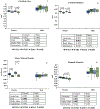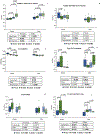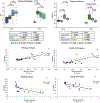Bone matrix quality in a developing high-fat diet mouse model is altered by RAGE deletion
- PMID: 35718325
- PMCID: PMC9296598
- DOI: 10.1016/j.bone.2022.116470
Bone matrix quality in a developing high-fat diet mouse model is altered by RAGE deletion
Abstract
Overweightness and obesity in adolescents are epidemics linked to chronic low-grade inflammation and elevated fracture risk. The increased fracture risk observed in overweight/obese adolescence contrasts the traditional concept that high body mass is protective against fracture, and thus highlights the need to determine why weight gain becomes detrimental to fracture during growth and maturity. The Receptor for Advanced Glycation End products (RAGE) is a central inflammatory regulator that can influence bone metabolism. It remains unknown how RAGE removal impacts skeletal fragility in overweightness/obesity, and whether increased fracture risk in adolescents could result from low-grade inflammation deteriorating bone quality. We characterized the multiscale structural, mechanical, and chemical properties of tibiae extracted from adolescent C57BL/6J (WT) and RAGE null (KO) mice fed either low-fat (LF) or high-fat (HF) diet for 12 weeks starting at 6 weeks of age using micro-computed tomography, strength, Raman spectroscopy, and nanoindentation. Overweight/obese WT HF mice possessed degraded mineral-crystal quality and increased matrix glycoxidation in the form of pentosidine and carboxymethyl-lysine, with HF diet in females only showing reduced cortical surface expansion and TMD independently of RAGE ablation. Furthermore, in contrast to males, HF diet in females led to more material damage and plastic deformation. RAGE KO mitigated glycoxidative matrix accumulation, preserved mineral quantity, and led to increased E/H ratio in females. Taken together, these results highlight the complex, multi-scale and sex-dependent relationships between bone quality and function under overweightness, and identifies RAGE-controlled glycoxidation as a target to potentially preserve matrix quality and mechanical integrity.
Keywords: Bone quality; Glycation; Mineralization; Obesity; RAGE.
Copyright © 2022 Elsevier Inc. All rights reserved.
Figures








Similar articles
-
High fat diet causes inferior vertebral structure and function without disc degeneration in RAGE-KO mice.J Orthop Res. 2022 Jul;40(7):1672-1686. doi: 10.1002/jor.25191. Epub 2021 Oct 21. J Orthop Res. 2022. PMID: 34676612 Free PMC article.
-
Induction and rescue of skeletal fragility in a high-fat diet mouse model of type 2 diabetes: An in vivo and in vitro approach.Bone. 2022 Mar;156:116302. doi: 10.1016/j.bone.2021.116302. Epub 2021 Dec 21. Bone. 2022. PMID: 34952229 Free PMC article.
-
Early- and life-long intake of dietary advanced glycation end-products (dAGEs) leads to transient tissue accumulation, increased gut sensitivity to inflammation, and slight changes in gut microbial diversity, without causing overt disease.Food Res Int. 2024 Nov;195:114967. doi: 10.1016/j.foodres.2024.114967. Epub 2024 Aug 23. Food Res Int. 2024. PMID: 39277266
-
Dietary glycation compounds - implications for human health.Crit Rev Toxicol. 2024 Sep;54(8):485-617. doi: 10.1080/10408444.2024.2362985. Epub 2024 Aug 16. Crit Rev Toxicol. 2024. PMID: 39150724
-
Advanced Glycation End Products, Diabetes, and Bone Strength.Curr Osteoporos Rep. 2016 Dec;14(6):320-326. doi: 10.1007/s11914-016-0332-1. Curr Osteoporos Rep. 2016. PMID: 27704396 Free PMC article. Review.
Cited by
-
High-fat and high-carbohydrate diets increase bone fragility through TGF-β-dependent control of osteocyte function.JCI Insight. 2024 Jul 9;9(16):e175103. doi: 10.1172/jci.insight.175103. JCI Insight. 2024. PMID: 39171528 Free PMC article.
-
The sex-specific effects of RAGE signaling and type 2 diabetes on mouse cortical bone mechanics, structure, and material properties.Mechanobiol Med. 2025 May 13;3(3):100132. doi: 10.1016/j.mbm.2025.100132. eCollection 2025 Sep. Mechanobiol Med. 2025. PMID: 40519864 Free PMC article.
-
Short-term high-fat diet impacts bone material properties and metabolism for adult and aged C57BL/6JN mice.Commun Biol. 2025 Jun 3;8(1):850. doi: 10.1038/s42003-025-08263-w. Commun Biol. 2025. PMID: 40461602 Free PMC article.
-
Fecal microbiota transplantation in mice improves bone material properties through altered mineral quality.JBMR Plus. 2025 Jul 8;9(9):ziaf115. doi: 10.1093/jbmrpl/ziaf115. eCollection 2025 Sep. JBMR Plus. 2025. PMID: 40861794 Free PMC article.
-
In vivo glycation-interplay between oxidant and carbonyl stress in bone.JBMR Plus. 2024 Aug 8;8(11):ziae110. doi: 10.1093/jbmrpl/ziae110. eCollection 2024 Nov. JBMR Plus. 2024. PMID: 39386996 Free PMC article. Review.
References
-
- Centers for Disease Control and Prevention, Childhood Obesity Facts, 2020. Retrieved from Overweight&Obesity: https://www.cdc.gov/obesity/data/childhood.html#:~:text=The%20prevalence....
Publication types
MeSH terms
Substances
Grants and funding
LinkOut - more resources
Full Text Sources
Molecular Biology Databases
Research Materials
Miscellaneous

